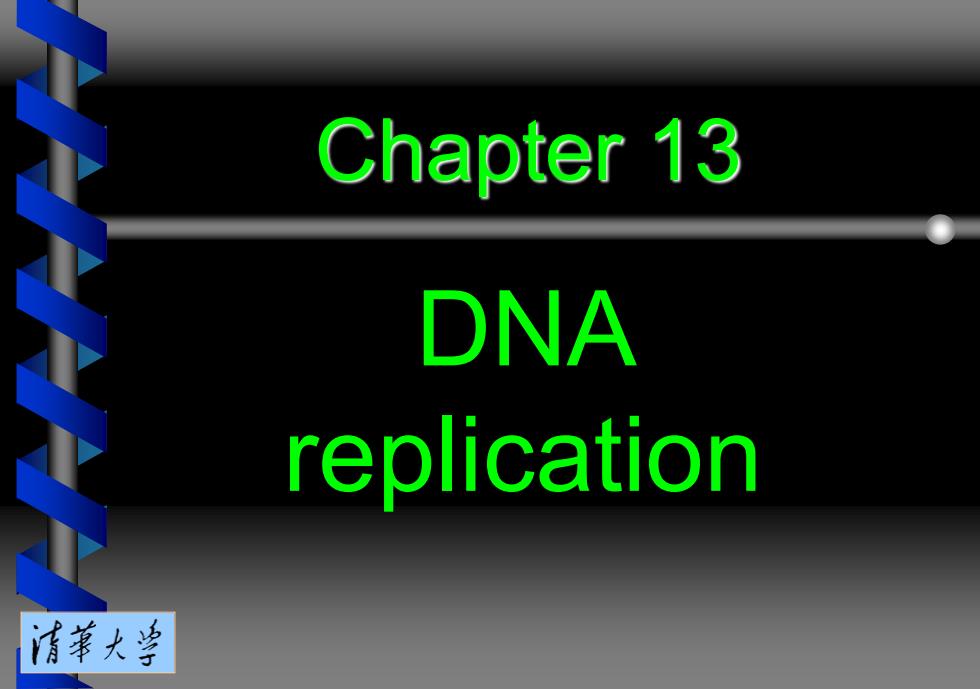
Chapter 13 DNA replication 清苇大当
Chapter 13 DNA replication
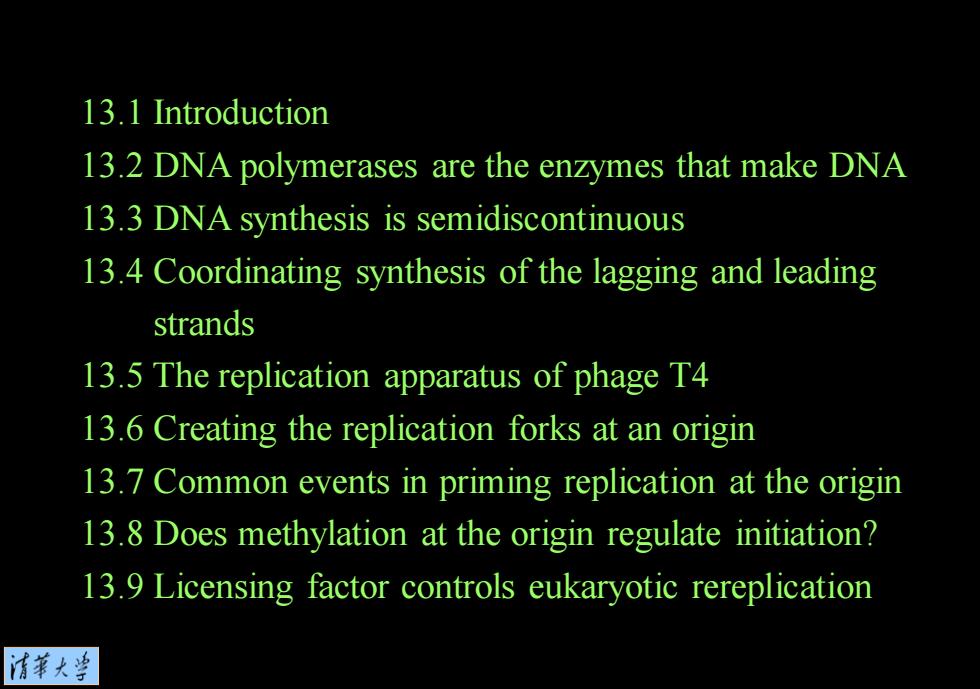
13.1 Introduction 13.2 DNA polymerases are the enzymes that make DNA 13.3 DNA synthesis is semidiscontinuous 13.4 Coordinating synthesis of the lagging and leading strands 13.5 The replication apparatus of phage T4 13.6 Creating the replication forks at an origin 13.7 Common events in priming replication at the origin 13.8 Does methylation at the origin regulate initiation? 13.9 Licensing factor controls eukaryotic rereplication 清菜大当
13.1 Introduction 13.2 DNA polymerases are the enzymes that make DNA 13.3 DNA synthesis is semidiscontinuous 13.4 Coordinating synthesis of the lagging and leading strands 13.5 The replication apparatus of phage T4 13.6 Creating the replication forks at an origin 13.7 Common events in priming replication at the origin 13.8 Does methylation at the origin regulate initiation? 13.9 Licensing factor controls eukaryotic rereplication
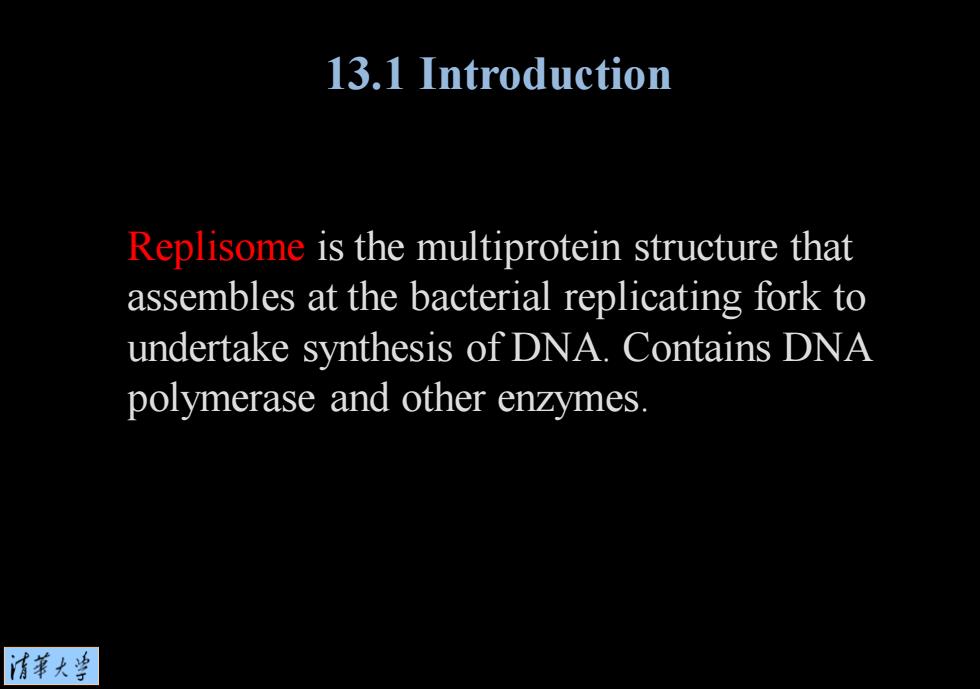
13.1 Introduction Replisome is the multiprotein structure that assembles at the bacterial replicating fork to undertake synthesis of DNA.Contains DNA polymerase and other enzymes 清苇大当
Replisome is the multiprotein structure that assembles at the bacterial replicating fork to undertake synthesis of DNA. Contains DNA polymerase and other enzymes. 13.1 Introduction
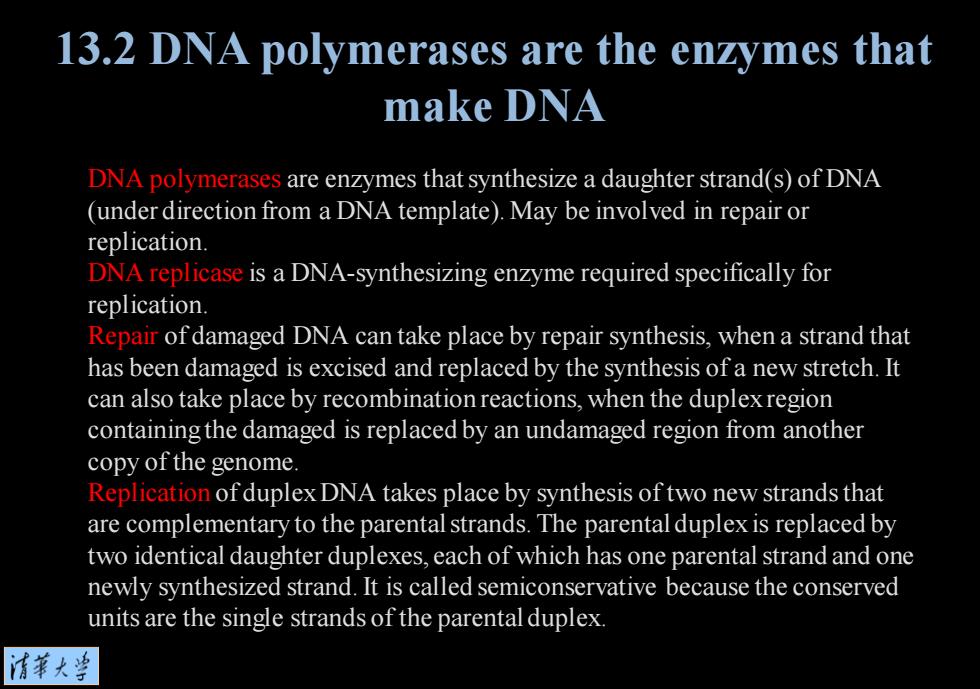
13.2 DNA polymerases are the enzymes that make DNA DNA polymerases are enzymes that synthesize a daughter strand(s)of DNA (under direction from a DNA template).May be involved in repair or replication. DNA replicase is a DNA-synthesizing enzyme required specifically for replication. Repair of damaged DNA can take place by repair synthesis,when a strand that has been damaged is excised and replaced by the synthesis of a new stretch.It can also take place by recombination reactions,when the duplexregion containing the damaged is replaced by an undamaged region from another copy of the genome. Replication of duplex DNA takes place by synthesis of two new strands that are complementary to the parental strands.The parental duplex is replaced by two identical daughter duplexes,each of which has one parental strand and one newly synthesized strand.It is called semiconservative because the conserved units are the single strands of the parental duplex. 情菜大学
DNA polymerases are enzymes that synthesize a daughter strand(s) of DNA (under direction from a DNA template). May be involved in repair or replication. DNA replicase is a DNA-synthesizing enzyme required specifically for replication. Repair of damaged DNA can take place by repair synthesis, when a strand that has been damaged is excised and replaced by the synthesis of a new stretch. It can also take place by recombination reactions, when the duplex region containing the damaged is replaced by an undamaged region from another copy of the genome. Replication of duplex DNA takes place by synthesis of two new strands that are complementary to the parental strands. The parental duplex is replaced by two identical daughter duplexes, each of which has one parental strand and one newly synthesized strand. It is called semiconservative because the conserved units are the single strands of the parental duplex. 13.2 DNA polymerases are the enzymes that make DNA

13.2 DNA polymerases are the enzymes that make 5'■ DNA 3' 都8PB88的2 5 Figure 13.1 Semiconservative 3 replication synthesizes two new strands of DNA 清菜大当
Figure 13.1 Semiconservative replication synthesizes two new strands of DNA. 13.2 DNA polymerases are the enzymes that make DNA
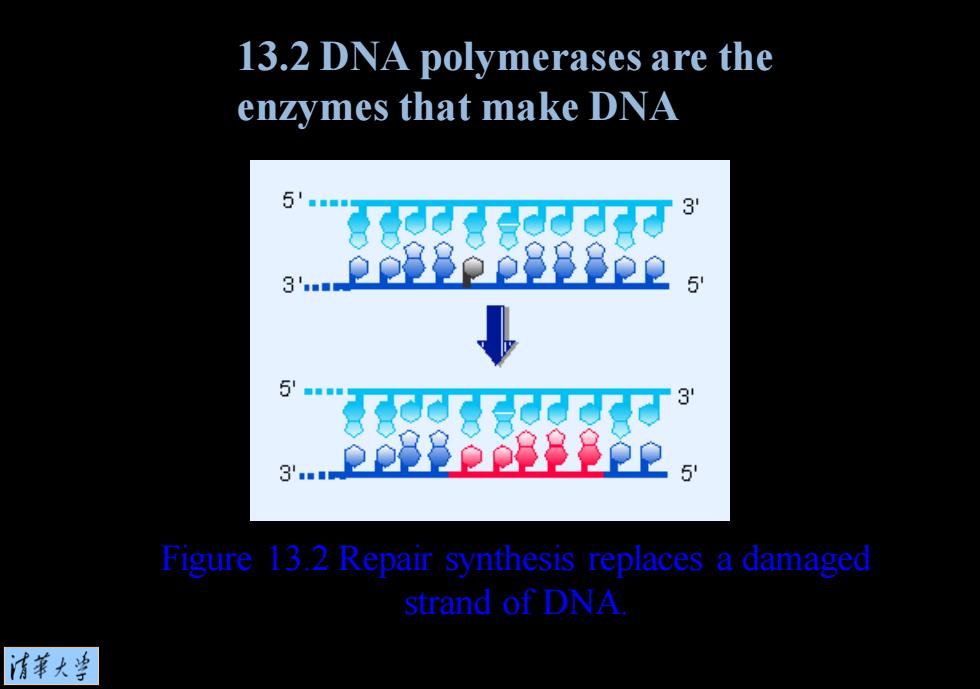
13.2 DNA polymerases are the enzymes that make DNA 5 3 3'l 8 Re8te088gee 5 Figure 13.2 Repair synthesis replaces a damaged strand of DNA 清菜大当
Figure 13.2 Repair synthesis replaces a damaged strand of DNA. 13.2 DNA polymerases are the enzymes that make DNA
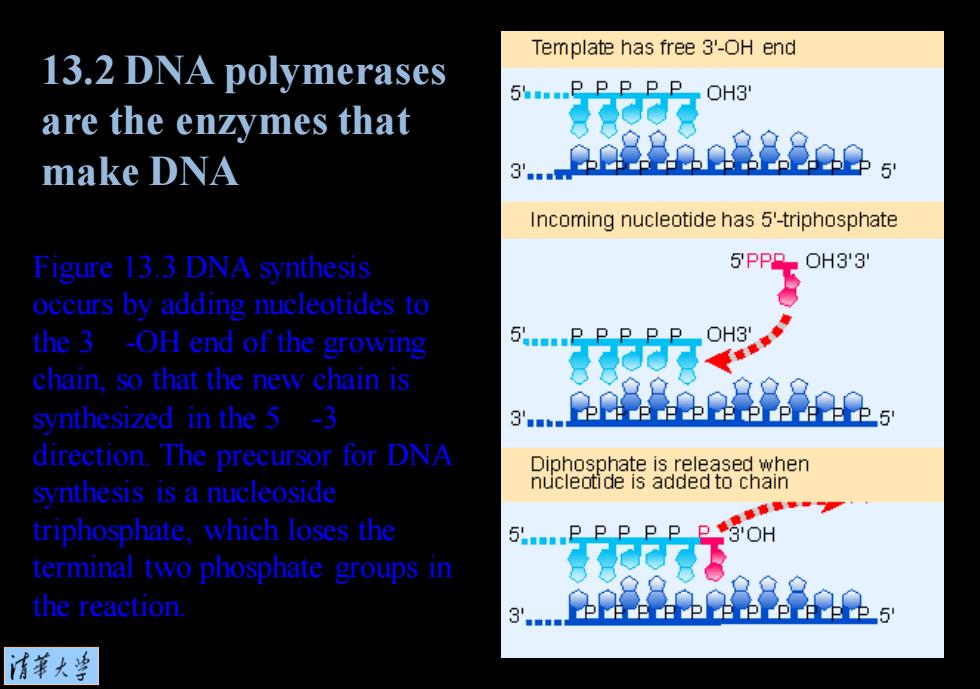
Template has free 3'-OH end 13.2 DNA polymerases 5.PP PP OH3 are the enzymes that make DNA 3'mn Incoming nucleotide has 5'-triphosphate Figure 13.3 DNA synthesis 5'PPR OH3'3' occurs by adding nucleotides to the 3 -OH end of the growing 5am.PPP2P、OH3 chain,so that the new chain is synthesized in the 5 -3 3'n 经P3经025 direction.The precursor for DNA Diphosphate is released when synthesis is a nucleoside nucleotide is added to chain triphosphate,which loses the 5P PPPP POH terminal two phosphate groups in the reaction. 3 清菜大当
Figure 13.3 DNA synthesis occurs by adding nucleotides to the 3 -OH end of the growing chain, so that the new chain is synthesized in the 5 -3 direction. The precursor for DNA synthesis is a nucleoside triphosphate, which loses the terminal two phosphate groups in the reaction. 13.2 DNA polymerases are the enzymes that make DNA
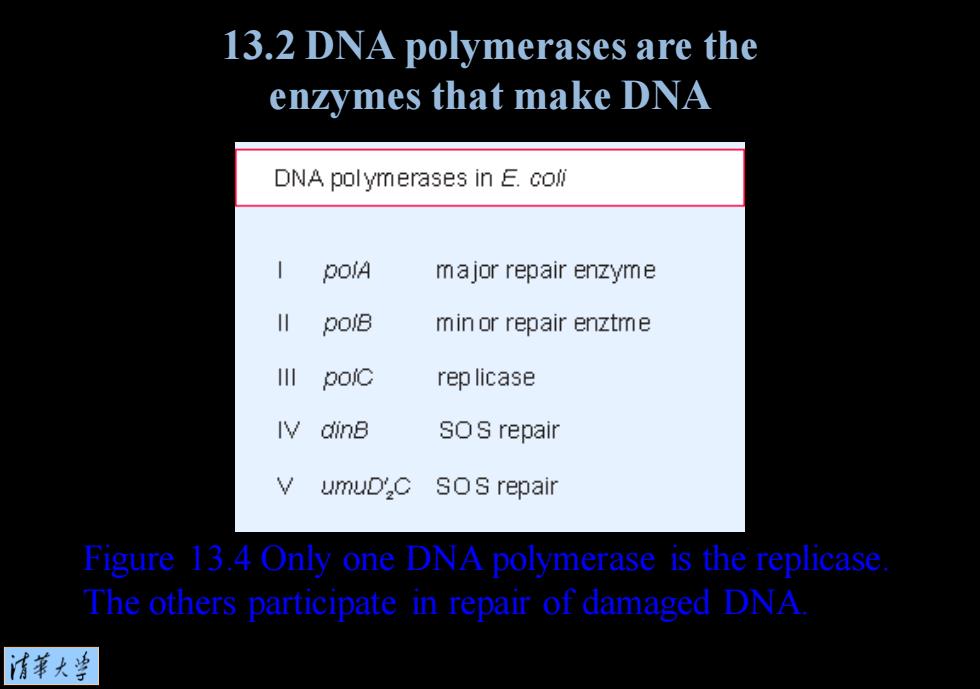
13.2 DNA polymerases are the enzymes that make DNA DNA polymerases in E.coli poiA ma jor repair enzyme poiB min or repair enztme 用 poiC rep licase IV dinB SOS repair umuD'C SOS repair Figure 13.4 Only one DNA polymerase is the replicase The others participate in repair of damaged DNA 清菜大当
Figure 13.4 Only one DNA polymerase is the replicase. The others participate in repair of damaged DNA. 13.2 DNA polymerases are the enzymes that make DNA
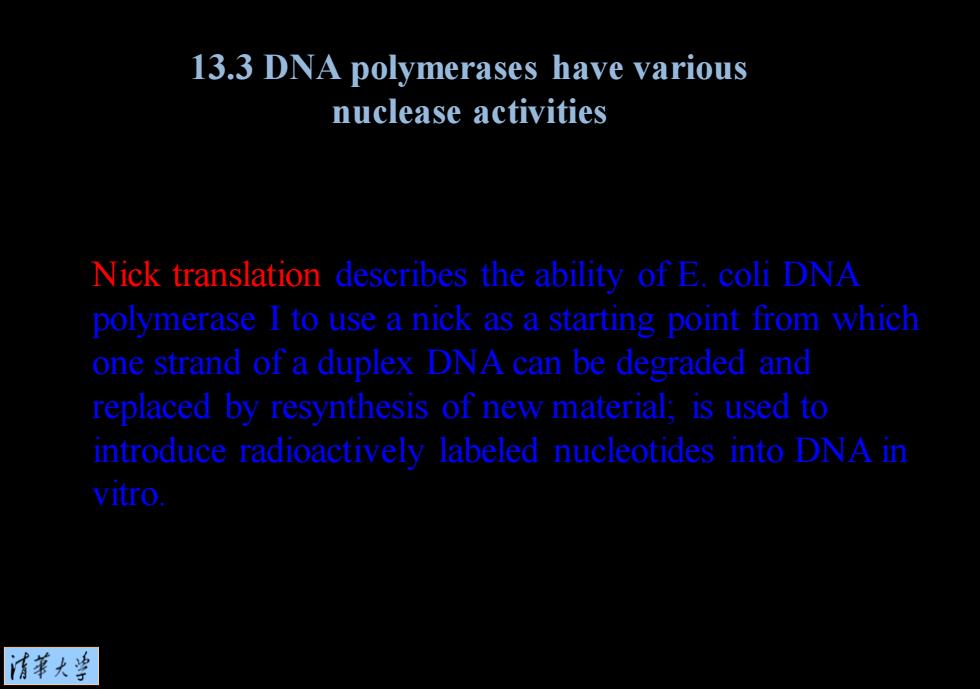
13.3 DNA polymerases have various nuclease activities Nick translation describes the ability of E.coli DNA polymerase I to use a nick as a starting point from which one strand of a duplex DNA can be degraded and replaced by resynthesis of new material: is used to labeled nucleotides into DNA vitro 清菜大当
Nick translation describes the ability of E. coli DNA polymerase I to use a nick as a starting point from which one strand of a duplex DNA can be degraded and replaced by resynthesis of new material; is used to introduce radioactively labeled nucleotides into DNA in vitro. 13.3 DNA polymerases have various nuclease activities
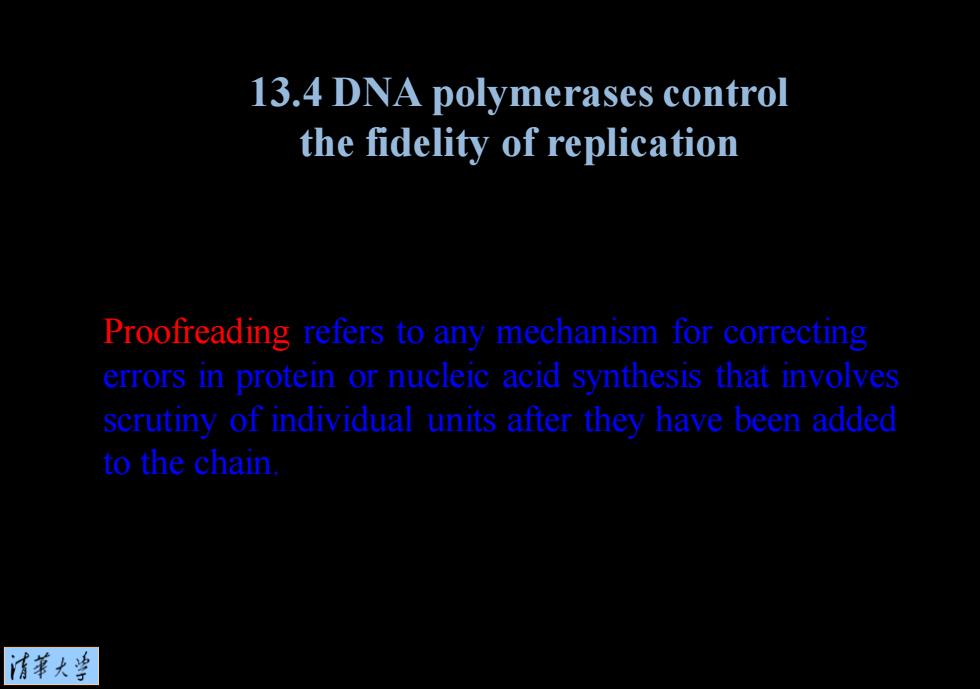
13.4 DNA polymerases control the fidelity of replication Proofreading refers to any mechanism for correcting errors in protein or nucleic acid synthesis that involves scrutiny of individual units after they have been added to the chain 清菜大当
Proofreading refers to any mechanism for correcting errors in protein or nucleic acid synthesis that involves scrutiny of individual units after they have been added to the chain. 13.4 DNA polymerases control the fidelity of replication